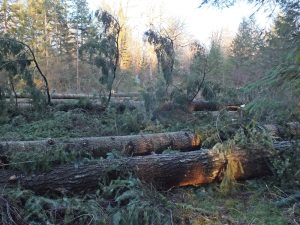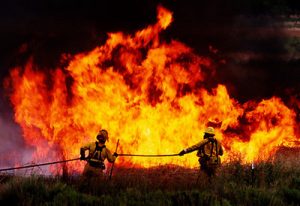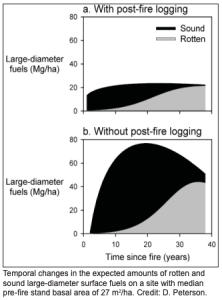2 Logging in Relation to Forests
Yanxin Wang and Xiangying Wang

With the development of various development technologies in modern society, it is convenient for people to exploit and utilize the forest resources in the Pacific Northwest. But at the same time, excessive logging has also destroyed the forest. With the rapid development of forest logging, the forests of the Pacific Northwest have been greatly affected.In this chapter, logging and its far-reaching effects on forests will be discussed in detail.
The professionals of the Center for the Study of the Pacific Northwest says that the history of the forest can be divided into four main periods. During the first period, when the lumber industry was still in its infancy, the Hudson’s Bay Company established the Pacific Northwest’s first mill at Fort Vancouver in 1828. The beginning of the California Gold Rush in 1848 brought a second phase. At this time, a number of outside investors built plants along Puget Sound, pushing the lumber industry to become dominant in the regional economy. The third era, from 1883 to 1940, produced significant capital investment and technological development, which allowed timber companies to intensively log areas they had previously been unable to reach. The expansion of railroads to the northwest helped the process along. This period was also marked by the increasing involvement of government and Labour in the timber industry. The government has implemented many reforms to conserve forest resources as much as possible and has protected some forest areas from further development. Unions also became active, demanding higher wages and better working conditions. The last phase From 1940 to the present, the relative importance of the lumber industry to Washington’s economy has declined. Even as logging reached record levels during and after World War II, the industry lost its position as the state’s largest employer. The postwar years also saw the growing strength of the environmental movement, which sought to keep loggers out of Washington’s vast forests. According to the article of this center, the recent controversy surrounding the forests of the Pacific Northwest reflects the long and complicated history of this natural resource. The Pacific Northwest has been associated with extensive forests and timber industries since the 18th century. Washingtonians have long coveted their state’s forests, but they value them for different reasons. The beliefs and actions of people in the past have shaped the forests we have today. First Nations used fire, and other groups used axes, railroads, chain saws and logging roads – as well as propaganda, presidential proclamations, soldiers, unions, lawsuits and wilderness rules – to transform forests. Forests, in turn, shape a country’s economy and the identity of its inhabitants.[1]
The most important impact of logging forests is the consequent loss of biological and genetic diversity. It is obvious that cutting down large areas of forest will lead to the loss of species. According to most studies, the harmful effects of logging have been underestimated and for some time concentrated on larger, more visible species, such as mammals, birds and flowering plants. Although these groups may suffer decline after logging, the effects tend to be localized and confused with certain species that show at least short-term increases. Over the years, this has weakened the “conservationist” response to forest loss. The effects of logging on invertebrates, lower plants and microscopic life forms are much greater, but are still generally unassessed and often unrecognized. [2]As Jack Ward Thomas, a Forest Service scientist who eventually became chief of the agency once said, “These forests are not only more complex than we think, they are more complex than we can think.” For example,the northern spotted owl, became the focus of questions about the impacts of clearcutting and extensive timber harvesting. Inhabiting the region’s old-growth forests, the northern spotted owl was declining in numbers and research indicated that extensive clearcutting of old forest habitat was contributing to the bird’s decline. [3]
Trees store carbon dioxide, so cutting them down releases carbon dioxide back into the atmosphere. With fewer trees to absorb carbon dioxide and eventually convert it, we end up increasing greenhouse gas emissions, which means higher global temperatures, altered weather and water patterns, and increased severity of extreme weather events.According to an article written by Kim Murphy, the thick, wet forests of the Pacific Northwest are the carbon storage powerhouses of the U.S. — in fact, they store more than 1-1/2 times as much carbon as the entire amount of carbon dioxide burned in fossil fuels throughout the country each year, a new study shows. [4] So the release of carbon dioxide from deforestation in the Pacific Northwest is huge.”They absorb as much or more carbon per acre than tropical forests,” said Beverly Lowe, a professor of global Change biology and terrestrial systems science at Oregon State University and a co-author of the study. “These are really what I call land sinks, and they’re very important to try and make sure we protect them.” Studies have shown that not cutting down trees in the Pacific Northwest is equivalent to stopping the region’s fossil fuel emissions for six to eight years.[5]
Post-fire Logging
Among the logging measures people take on forests, there is a more specific type of logging called post-fire logging. Post-fire logging generally occurs after logging fires after recovery from fires. Regarding the usefulness of this measure, a large number of people are paying attention to a discussion about whether post-fire logging is more good or harmful for forests. In the following part of the chapter, I will present the impact of post-fire logging based on different elements.

According to the investigation on post-fire soil management, it stated that “In many cases salvage logging is carried out in the period immediately after a fire”, the first importance to the forest is the post-fire logging.[6] Changes were produced in the soils after the fires. One of the most obvious findings is the reduction of organic carbon in the soil.[7]Organic carbon in the soil performs a crucial role. The presence of organic carbon promotes microaggregation, reduces the risk of soil compaction, and improves water retention.[8] Rescuing timbers immediately after a fire can prevent the value of timber from decreasing over time. Based on the research, if timber is not removed promptly after a fire, their ability to recover can be slowed by nutrient loss and erosion in the soil after a fire.[9] In addition to the damage done to the trees themselves, the soil as well is affected, and the effects of this damage are reciprocal. Timber removal measures taken after a wood fire appear to contribute to the recovery of soil and vegetation after the fire.
The contribution of post-fire felling to fuel is also not negligible. In fires, forest stands are divided into fine fuels and coarse fuels. McIver (2000) demonstrated that fine fuels are the main driver of fire spread. Coarse fuels can also contribute to fire exacerbation. Due to the large localized area of coarse fuels, it increases the length of time of burning and the degree of heating of the soil. This leads to severe burning levels.[10] A McGinnis (2010) study indicated that there was a significant increase in woody debris following post-fire logging activities in the Sierra Nevada. This is tantamount to a raising in fire occurrence. In the other case, Dorhan’s (2011) study indicated that the accumulation of these fuels was more likely to contribute to the likelihood of fires.[11] “Large downed logs began to rot at about 15 years post-fire, and more than half were rotten within 30 years.” There is a higher probability of inside-burning fires in rotted timber than in solid timber, since rotted timber burns completely. Plant germination can be reduced by long-burning logs as they heat up the soil, burn soil nutrients, and damage soil productivity.[12] To conclude all above together, the analyses illustrate that post-fire logging leads to an increased risk of recurrent forest fire.

Post-fire logging also has some impact on the ecosystem of the site. The impact of these logging practices can be seen in the migration of some animals, and McIver (2000) mentioned in his study that birds that prefer extensive habitats and dead wood benefit more from logging. In contrast, birds that prefer to roost in nests receive barriers. For mammals, predominantly gregarious animals prefer vast open habitats. And it is easier to forage in a wide habitat. They benefit accordingly from post-fire logging. However, according to Hebblewhite, M., et al.(2019), elk avoid areas that have been logged after fires because wolves are more likely to predate on them. The authors state that this is a disruption of the ecosystem.[13] Invertebrates are the ones that can have a direct impact on the trees and soil in a forest.[14] They can serve as food for birds and can accelerate the decay of trees that have been burned by fire, thus affecting the nutrient content of the soil. Post-fire harvesting can greatly reduce the number and diversity of such populations. As a result, the nutrients in the soil are reduced.[15]
The impact of fire on forests and other management measures regarding forest fires, please read the chapter of History of Wildfires and Wildfire Management if you want to learn more about.
- Center for the Study of the Pacific Northwest. Seeing the Forest for the Trees: Placing Washington's Forests in Historical Context. https://www.washington.edu/uwired/outreach/cspn/Website/Classroom%20Materials/Curriculum%20Packets/Evergreen%20State/Section%20II.html . Accessed 2007. ↵
- Eruotor o.rex. Logging and its impact on forests as a life source. https://www.fao.org/3/xii/0751-B1.htm. Accessed 2020. ↵
- Kathleen’s Gobush,PHD. Pacific Northwest Forests: Sustainning Wildlife, People and the Planet. https://defenders.org/blog/2021/03/pacific-northwest-forests-sustaining-wildlife-people-and-planet. Accessed March 3, 2021. ↵
- Kim Murphy. Pacific Northwest forests act as massive carbon banks. https://www.latimes.com/archives/blogs/greenspace/story/2010-03-04/pacific-northwest-forests-act-as-massive-carbon-banks. Accessed March 4 2010. ↵
- Cassandra Profita. Pacific Northwest forests fit trifecta for curbing climate change — if we stop logging them. https://crosscut.com/2020/01/pacific-northwest-forests-fit-trifecta-curbing-climate-change-if-we-stop-logging-them. Accessed January 1,2020. ↵
- Pereira, Paulo, et al. “Contents.” Current Opinion in Environmental Science & Health, vol. 5, 2018, pp. 26–32. https://www.sciencedirect.com/science/article/pii/S2468584418300217?via%3Dihub ↵
- Jennings, Tara N., et al. “Impact of Postfire Logging on Soil Bacterial and Fungal Communities and Soil Biogeochemistry in a Mixed-Conifer Forest in Central Oregon.” Plant and Soil, vol. 350, no. 1-2, 2012, pp. 393–411, https://doi.org/10.1007/s11104-011-0925-5. ↵
- BLANCO-CANQUI, Humberto, et al. “Soil Organic Carbon: The Value to Soil Properties.” Journal of Soil and Water Conservation, vol. 68, no. 5, 2013, pp. 129–134A, https://doi.org/10.2489/jswc.68.5.129A. ↵
- Pereira, Paulo, et al. “Contents.” Current Opinion in Environmental Science & Health, vol. 5, 2018, pp. 26–32. https://www.sciencedirect.com/science/article/pii/S2468584418300217?via%3Dihub ↵
- McIver, James D. Environmental Effects of Postfire Logging : Literature Review and Annotated Bibliography / Technical Editors James D. McIver and Lynn Starr. U.S. Dept. of Agriculture, Forest Service, Pacific Northwest Research Station, 2000. ↵
- McGinnis, Thomas W., et al. “Fuel Buildup and Potential Fire Behavior after Stand-Replacing Fires, Logging Fire-Killed Trees and Herbicide Shrub Removal in Sierra Nevada Forests.” Forest Ecology and Management, vol. 260, no. 1, 2010, pp. 22–35, https://doi.org/10.1016/j.foreco.2010.03.026. ↵
- [Drohan, Joy. "Post-fi re Logging: An Effective Tool for Managing Future Fuels in Coniferous Inland Northwest Forests." (2011). ↵
- Hebblewhite, M., et al. “Trophic Consequences of Postfire Logging in a Wolf–ungulate System.” Forest Ecology and Management, vol. 257, no. 3, 2009, pp. 1053–62, https://doi.org/10.1016/j.foreco.2008.11.009. ↵
- McIver, James D. Environmental Effects of Postfire Logging : Literature Review and Annotated Bibliography / Technical Editors James D. McIver and Lynn Starr. U.S. Dept. of Agriculture, Forest Service, Pacific Northwest Research Station, 2000. ↵
- Cobb, Tyler P., et al. “Wood-Feeding Beetles and Soil Nutrient Cycling in Burned Forests: Implications of Post-Fire Salvage Logging.” Agricultural and Forest Entomology, Accepted 26 January 2009First published online 22 October 2009, vol. 12, no. 1, 2010, pp. 9–18, https://doi.org/10.1111/j.1461-9563.2009.00440.x. ↵

